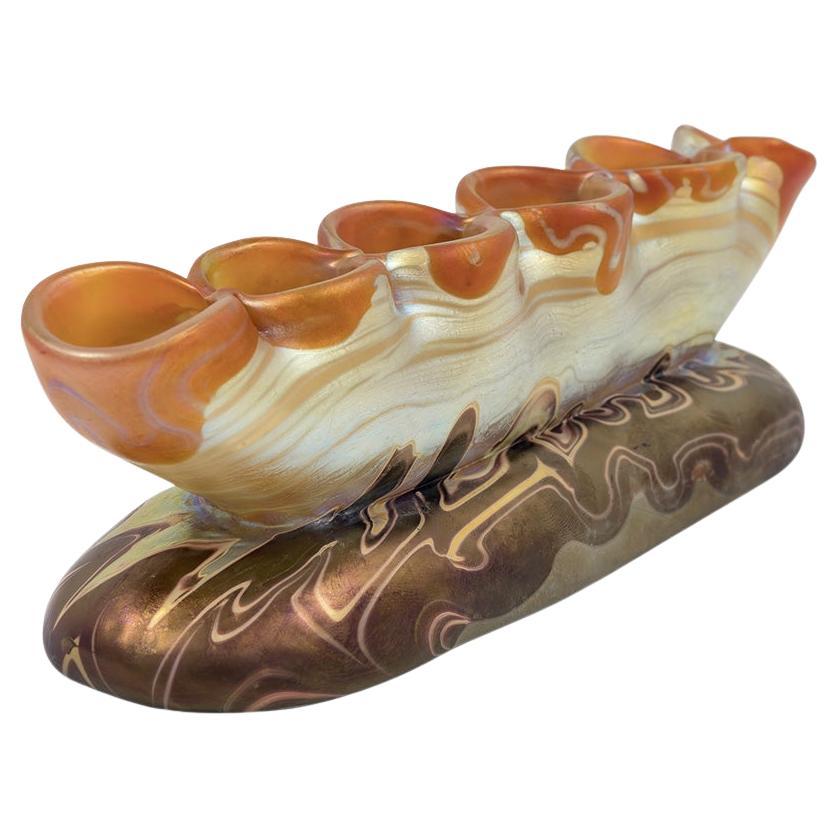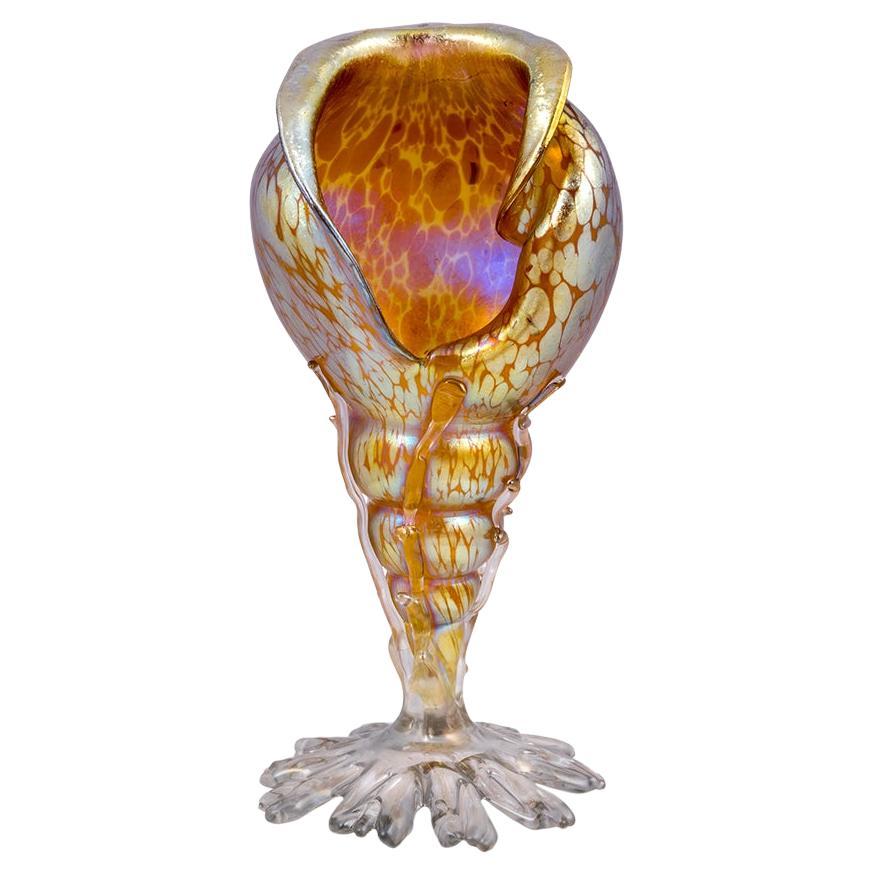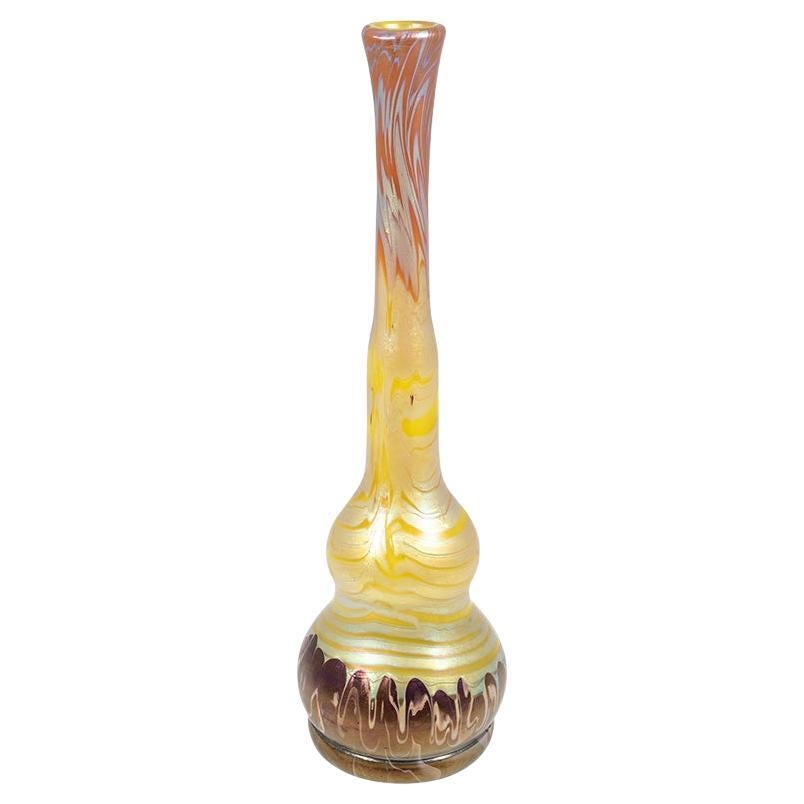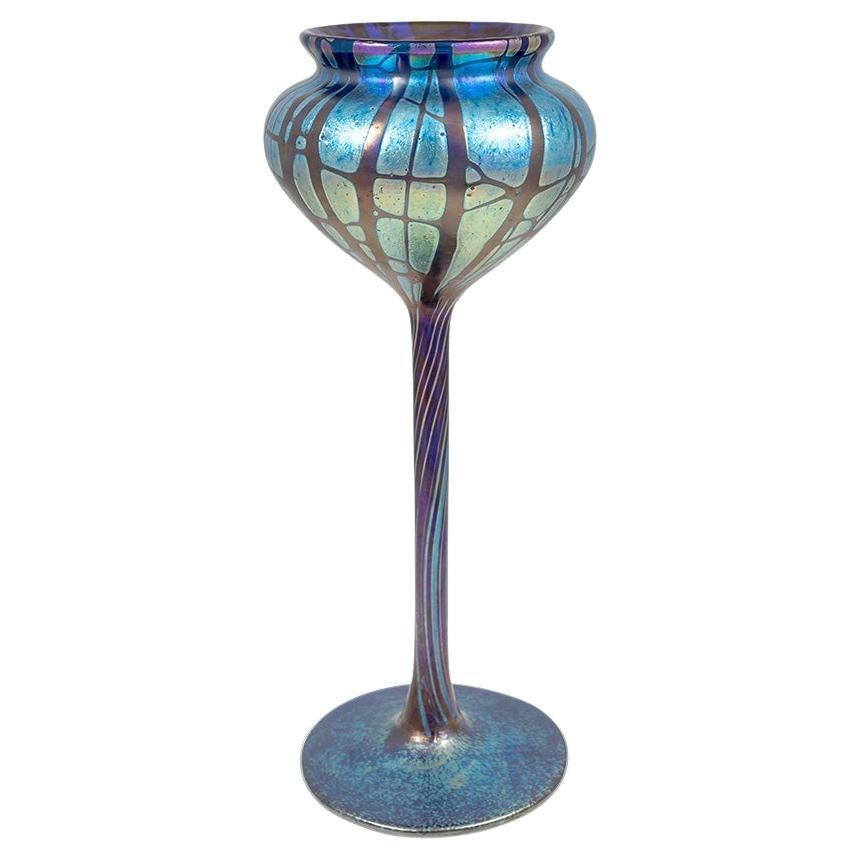Items Similar to Colorful Candlestick Glass Loetz circa 1900 Austrian Art Noveau
Want more images or videos?
Request additional images or videos from the seller
1 of 8
Colorful Candlestick Glass Loetz circa 1900 Austrian Art Noveau
About the Item
Glass Candlestick Johann Loetz Witwe PG 358 decoration circa 1901
This candlestick with its PG 358 decoration is known from the world exhibition in Paris 1900. World exhibitions were an enormously important advertising factor for Arts & Crafts manufactories, as the audience for these events attended from all over the world. For the Loetz glassworks, it represented an important milestone in its company history. The candlestick is mould-blown, freeformed, reduced and iridescent and has a brass attachment which holds the candle.
glass, mould-blown and freeform, reduced and iridescent; brass fixture
- Creator:Loetz Glass (Manufacturer)
- Dimensions:Height: 3.55 in (9 cm)Diameter: 4.73 in (12 cm)
- Style:Jugendstil (Of the Period)
- Materials and Techniques:
- Place of Origin:
- Period:
- Date of Manufacture:1900
- Condition:Wear consistent with age and use.
- Seller Location:Klosterneuburg, AT
- Reference Number:
About the Seller
5.0
Vetted Seller
These experienced sellers undergo a comprehensive evaluation by our team of in-house experts.
Established in 2013
1stDibs seller since 2021
13 sales on 1stDibs
Typical response time: <1 hour
- ShippingRetrieving quote...Ships From: Klosterneuburg, Austria
- Return PolicyA return for this item may be initiated within 14 days of delivery.
More From This SellerView All
- Inkwell Loetz Art Noveau, circa 1900By Loetz GlassLocated in Klosterneuburg, ATInkwell Johann Loetz Witwe PG 358 decoration circa 1901 This inkwell with its PG 358 decoration is known from the world exhibition in Paris 1900. World exhibitions were an enormou...Category
Antique Early 1900s Austrian Jugendstil Glass
MaterialsGlass
- Glass Centerpiece Loetz Austrian Jugendstil, circa 1900By Loetz GlassLocated in Klosterneuburg, ATAustrian Jugendstil glass centerpiece with six openings, Johann Loetz Witwe circa 1900 Phenomen Genre 358 decoration This glass centerpieces is an extraordinary example of the Loe...Category
Early 20th Century Austrian Jugendstil Glass
MaterialsGlass
- Conch Shell Glass Vase Iridescent Handmade Loetz Austria Jugendstil, circa, 1900By Loetz GlassLocated in Klosterneuburg, ATConch shell glass vase handmade by Johann Loetz Witwe Austria/Bohemia Jugendstil circa 1902 "Candia Papillon" Decoration. The extravagant Candia Papillon decor lends a special brilliance to the shell shape of this collectible. The iridescent quality of this decoration not only encompasses the outside of the intricately applied silver crumbled dots, but extends into the interior of the glass shell. A characteristic of this scroll vase...Category
Antique Early 1900s Austrian Jugendstil Vases
MaterialsArt Glass, Blown Glass
- Bohemian Glass Vase Loetz PG 358 circa 1900 Art NouveauBy Loetz GlassLocated in Klosterneuburg, ATAustrian Jugendstil glass vase manufactured by Johann Loetz Witwe, Phenomen Genre 358 decoration, circa 1900 This glass vase is an extraordinary example of the Loetz manufactory its...Category
Early 20th Century Austrian Jugendstil Glass
MaterialsGlass
- Bohemian Glass Vase Loetz PG 358 circa 1900 Art NouveauBy Loetz GlassLocated in Klosterneuburg, ATAustrian Jugendstil glass vase manufactured by Johann Loetz Witwe, Phenomen Genre 358 decoration, circa 1901 This glass vase is an extraordinary example of the Loetz manufactory its...Category
Early 20th Century Austrian Jugendstil Glass
MaterialsGlass
- Bohemian Glass Vase Loetz circa 1900 Pampas Cobalt Art Nouveau BlueBy Loetz GlassLocated in Klosterneuburg, ATBohemian glass vase, manufactured by Johann Loetz Witwe, Pampas Cobalt decoration, ca. 1899, Blue, Silver, Viennese Art Nouveau, Jugendstil, Art Deco, art glass, iridescent glass. T...Category
Early 20th Century Austrian Jugendstil Glass
MaterialsGlass
You May Also Like
- Loetz Art Nouveau Glass Vase Bronze Phenomenon Genre 29, Austria-Hungary, C 1900By Loetz GlassLocated in Vienna, ATFinest Bohemian Art Nouveau Glass Vase: In shape blown low, cambered body on a large, round floor plan, triple indented wall with a mouth rim formed into a three-pass shape, polished...Category
Antique Early 1900s Austrian Art Nouveau Glass
MaterialsGlass
- Loetz Art Nouveau Glass Vase Phenomenon Genre 1/104, Austria-Hungary, Ca 1900By Loetz GlassLocated in Vienna, ATFinest Bohemian Art Nouveau Glass Vase: Blown into shape of raised body on a round ground plan, triple depressed wall with mouth rim formed into trefoil, polished pontil, with groun...Category
Antique Early 1900s Austrian Art Nouveau Glass
MaterialsGlass
- Loetz Art Nouveau Glass Vase Phenomenon Gre Crete 6893, Austria-Hungary, Ca 1900By Loetz GlassLocated in Vienna, ATFinest Bohemian Art Nouveau Glass Vase: Blown into form baluster-shaped body with discus-shaped protruding belly part, attached spherical curved neck with flared mouth rim, stepped f...Category
Antique Early 1900s Austrian Art Nouveau Glass
MaterialsGlass
- Loetz Art Nouveau Glass Vase Phenomenon Gre Crete 7767, Austria-Hungary, Ca 1900By Loetz GlassLocated in Vienna, ATFinest Bohemian Art Nouveau Glass Vase: Shaped, blown, bulbous body with 12-lobed, slightly ribbed wall on a flush, round base, the wall raised to a spherical oval shape, slightly fl...Category
Antique Early 1900s Austrian Art Nouveau Glass
MaterialsGlass
- Vase Loetz , Style : Art Nouveau , Bohemia, circa 1900By Loetz GlassLocated in Ciudad Autónoma Buenos Aires, CLoetz The glass factory, originally founded in 1836 by Johann Baptist Eisner, was taken over. Loetz was the premier Bohemian glass works during this period. It was located in Klostermühle, near Rejštejn in the Sušice district in South-West Bohemia, which belonged to the Austro-Hungarian Empire until 1918. Susanna Loetz, widow of Glass entrepreneur Johann Loetz in 1852. She renamed the company "Glasfabrik Johann Loetz Witwe", a name that was retained until all activities were stopped in 1947. In 1879 it passed to Max Ritter von Spaun. Under his guidance, together with director Eduard Prochaska, the glassworks flourished as never before and enjoyed its most successful period. Von Spaun and Prochaska concentrated on the development of innovative glass types and new production techniques. Their first successful speciality was a glass type simulating semiprecious stones. It is often called "Marmoriertes Glas" ("marbled glass"). The range contained Onyx (red/brown), Karneol (red/pink) and later Malachit (green). It was introduced in the second half of the 1880's. From the same period dates the Octopus glass, of which the decor resembles the tentacles of a cephalopod. The production of Marmorier-tes Glas was resumed in 1906, in different colours like yellow and white. Octopus, 1885-1890, 1885-1890, unknown, an Malachit, 1885-1890, unknown, The master glass-blowers of Klostermühle had already carried out experiments with iridescence in the first half of the 1890's, and they produced the Olympia, a classically inspired olive green type, in 1896. Similar, in variants of creta green, bronce or Olympia and averse to any redundant decoration was the Glatt decor. It highly contrasted with the more elaborate finishes of that time, but it constitutes a part of the production with a deep sense for taste and quality. Most of the pieces shown in the "Glatt" decors were manufactured for Max Emmanuel in London. The glatt decor remained in use for many years. The Chiné decor had thin glass threads spun around the body in irregular patterns. It is not to be confused with the type of glass that was produced by Kralik. Loetz "Chiné" came in clear, opal, green and pink, Kralik "Chiné" in dark purple. The logical sequel to Chiné was the Pampas decor, green or cobalt blue, in which the threads almost disappeared in the surface, with iridised parts in between. Around the same time the dotted Papillon decor was introduced. The beautiful silver spots were employed on a wide array of models and quite effective on the gooseneck (water sprinkler) and sea shell...Category
Antique Early 1900s Austrian Art Nouveau Glass
MaterialsArt Glass
- Loetz Art Nouveau Glass Vase Phenomenon Genre 7734, Austria-Hungary, circa 1898By Loetz GlassLocated in Vienna, ATMold-blown, baluster-shaped body on a flush stand, raised, widening, ribbed on the inside, forming a slight shoulder and short, straight neck, as well as stand area with ribs on the ...Category
Antique 1890s Austrian Art Nouveau Glass
MaterialsGlass
Recently Viewed
View AllMore Ways To Browse
De Rupel Boom
Georg Jensen Glassware
Rupel Boom
Georgian Glass Carafe
Luigi Bormioli Vintage
Luigi Bormioli
Moser 24k
Swarovski Wine Glass
Antique Hand Blown Glass Swans
Arcoroc France Bowl Vintage
Caraffe Vintage
Crystal Napkin Rings
Czech Bohemian Glass Goblet And Cover
Dean Norton
Egermann Ruby
Individual Salt Cellars
Lalique Argos
Marigold Carnival Glass





